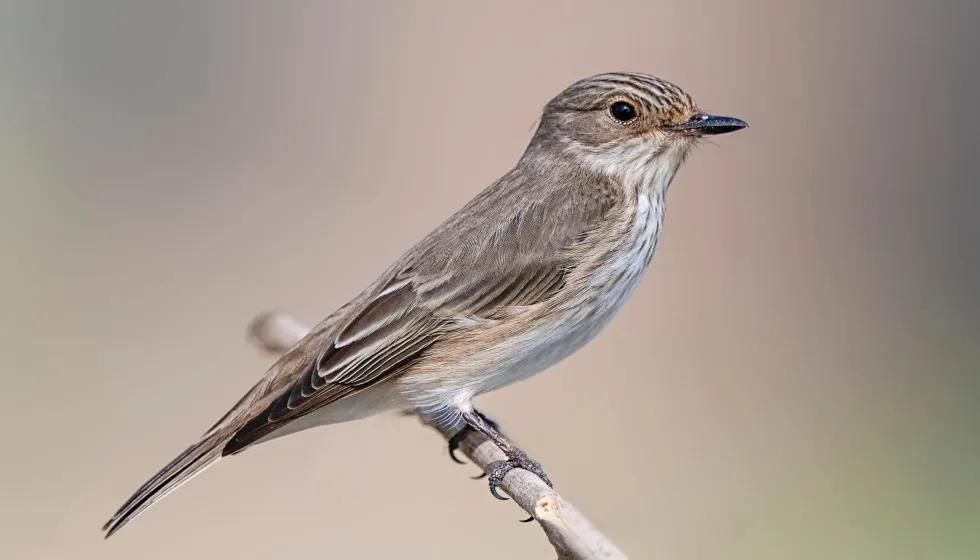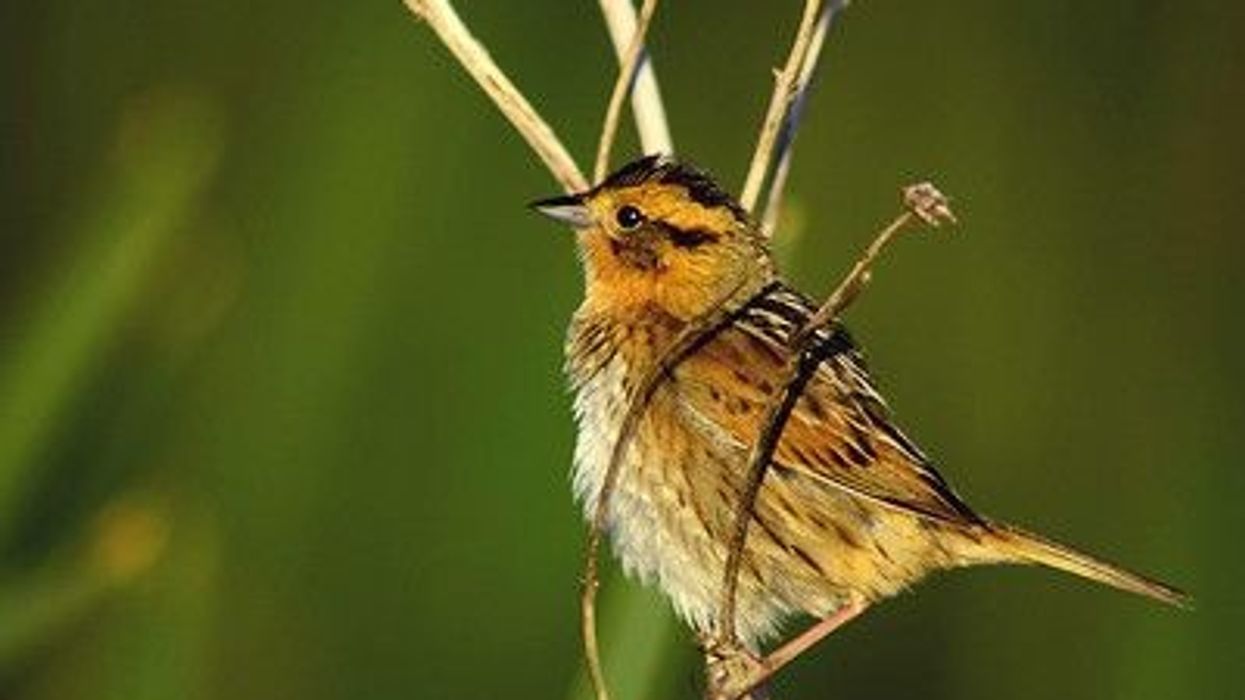The spotted flycatcher is an Old World flycatcher bird species found mostly in the continents of Europe, Asia, and Africa. Europe and western Asia make up its breeding season habitats where the spotted flycatcher habitat changes to sub-Saharan Africa and southwestern Asia.
Spotted flycatcher migration takes place in large flocks, but other than this it is a largely solitary bird that is territorial about its nests and perches.
It is also monogamous, having two broods with the same mate in a given breeding season. It favors open woodlands, riverine areas, and urban places like gardens, parks, and avenues and it usually lives for around two years.
It is a mostly brown and white small bird with dark streaks.
The spotted flycatcher is unique in the sense that it can recognize its own egg, a characteristic not shared by many other birds. Its population shows a declining trend because of habitat decline, but it is still considered a species of Least Concern by the IUCN.
For more great content, check out these great green macaw facts and Pesquet's parrot facts for kids.
Spotted Flycatcher Interesting Facts
What type of animal is a spotted flycatcher?
The spotted flycatcher (Muscicapa striata) is a bird.
What class of animal does a spotted flycatcher belong to?
The spotted flycatcher (Muscicapa striata) bird belongs to the Aves class of animals.
How many spotted flycatchers are there in the world?
There are 54,000,000-83,999,999 mature individuals of the spotted flycatcher (Muscicapa striata) species in the world.
Where does a spotted flycatcher live?
The spotted flycatcher (Muscicapa striata) bird is usually found in most of Europe and Asia, mainly in western Asia. These two continents make up its breeding grounds. During winter, the spotted flycatcher range changes to warmer habitats in southwestern Asia and sub-Saharan Africa. Spotted flycatcher distribution over these three continents is quite extensive.
What is a spotted flycatcher's habitat?
The spotted flycatcher bird tends to inhabit open woodlands, avenues, gardens, parks, forest edges, clearings, and trees close to rivers or other water bodies. It likes an open view of its surroundings and prefers mature trees.
It prefers similar habitats during both the breeding and migrating seasons. During the breeding season, it lives at sea level to elevations up to 6,561 ft (2,000 m), and during the migration season, it can be seen up to elevations of up to 9,842 ft (3,000 m).
Who do spotted flycatchers live with?
Spotted flycatchers are seen alone or in pairs. They may also be seen with familial groups or in big flocks while migrating. Territorial and defensive displays to defend their solitary nests and perches are common among spotted flycatchers.
How long does a spotted flycatcher live?
The average spotted flycatcher life-span lasts for around two years, but some individuals have been known to live up to eight years.
How do they reproduce?
The spotted flycatcher reproduces by mating and laying eggs. The male performs a display and sings to attract females to the nest site.
Its throat and crown feathers are ruffled, and it moves its head in all directions while flicking its tail. Then after breeding between May and August, tree nests made from rootlets, moss, dry grass, feathers, dead leaves, and fine twigs are built by mostly the female.
Between two and seven eggs are laid and incubated by the female for 10-17 days. The young chicks are given food by both parents and they leave 12-17 days after hatching.
They may still depend for food on their parents for two more weeks. Two broods are laid in a given season by each monogamous pair.
What is their conservation status?
The conservation status of the spotted flycatcher according to the International Union for Conservation of Nature is Least Concern. This shows that the bird is not rare and it is quite commonly found in its range.
Spotted Flycatcher Fun Facts
What do spotted flycatchers look like?
Spotted flycatcher adults have gray-brown upper parts and dark upper wings. The underparts are a dull white and the breast, thighs, and flanks have a tinge that is a pale gray-buff color.
The feathers on the lower, middle, and base of the wing coverts have buffy-white edges. The rectrices have white tips and are dark brown in color.
The coverts on the upper tail have pale gray edges. There are fine, gray-brown streaks on the upper flanks, sides of the throat, and the chin, crown, and breast.
The gray-brown underwing-coverts have edges that are broad and pale-buff. The head of the spotted flycatcher is gray-brown like the upper parts, but with blackish-brown streaks. The forehead and forecrown are pale and the lores tend to be whitish.
The bill is black or blackish-brown and has a broad but pointed shape, with the lower mandible being paler than the upper one. The feet and legs are short and are also blackish-brown and the eyes are a darker shade of brown.
Spotted flycatchers show no sexual dimorphism and juveniles look similar but browner than adults. There are subspecies that show slight variations in color grading, size, and streaks.

How cute are they?
Spotted flycatchers are really cute birds. They are small, pale, and beautifully fragile creatures. They sing sweet songs, mate for life, and are very smart since they are able to recognize their eggs which most other birds can't. They have an elegance about them and are often seen standing upright when perching.
How do they communicate?
Spotted flycatchers communicate via songs and calls. The most recognizable calls are the harsh 'chirrt' and the thin 'zeee'.
When alarmed, they use the rattling 'ch-r-r-r-r-rer' or a 'zee-zucc' or 'tek-tek' call. Their song, on the other hand, is a series of notes that are short and squeaky along with high-pitched utterings and trills that overall sound like 'sip-sip-sree… sree-tisree-sip…' or 'sip-sip-see-sitti-se-see'.
During nest and perch defense, spotted flycatchers are known to flick their wings and jerk their tails.
How big is a spotted flycatcher?
Spotted flycatchers are 5.1-6 in (13-15 cm) long and they have a wingspan of 9.5 in (24 cm) which makes them four to six times smaller than Cooper's hawks, and two to seven times bigger than the bee hummingbird. The average spotted flycatcher size is about the same as that of the vermilion flycatcher.
How fast can a spotted flycatcher fly?
Spotted flycatchers, being small birds, can be assumed to reach speeds of around 25 mph (40 kph), but when they are sallying (leaping forth suddenly) for insect prey, or avoiding predators, they move considerably faster.
How much does a spotted flycatcher weigh?
A spotted flycatcher weighs around 0.4-0.8 oz (11-22 g).
What are the male and female names of the species?
Males and females of the spotted flycatcher species can be called 'cocks' and 'hens', but they aren't generally referred to with those names.
What would you call a baby spotted flycatcher?
Spotted flycatcher babies are called 'chicks'.
What do they eat?
Spotted flycatchers feed mostly on insects but also on earthworms, spiders, snails, berries, and small fruits. The insects that they prefer are flies, moths, butterflies, grasshoppers, crickets, locusts, beetles, and true bugs. They themselves get preyed upon by Eurasian jays and domestic cats.
Are they dangerous?
No, spotted flycatchers are not dangerous.
Would they make a good pet?
Spotted flycatchers are wild Old World birds that should not be taken as pets. Although they are a species of Least Concern, their populations show a declining trend because of old tree removal, habitat deterioration, and contamination of insects. Spotted flycatcher populations should be preserved.
Did you know...
Spotted flycatchers are 'sallying' birds, meaning that they swoop down quickly on prey from their perches. They stick with a perch to hunt if they like it.
What are the different types of flycatchers?
There are two basic types of flycatchers: Old World flycatchers of the family Muscicapidae and New World flycatchers (also called tyrant flycatchers) of the family Tyrannidae. These two families bear only a superficial resemblance to each other.
Tyrant flycatchers are overall smaller in size than Old World flycatchers. There are at least 332 different species of Old World flycatchers and 437 species of tyrant flycatchers.
Old World flycatchers include the olive-striped flycatcher, the gray-hooded flycatcher, the orange-banded flycatcher, Euler's flycatcher, and the spotted flycatcher. Tyrant flycatchers include scissor-tailed flycatchers, least flycatchers, and great crested flycatchers.
Do spotted flycatchers migrate?
Yes, spotted flycatchers migrate from their European and Asian breeding grounds to warmer but similar habitats in sub-Saharan Africa and southwestern Asia. They tend to migrate in big flocks.
Here at Kidadl, we have carefully created lots of interesting family-friendly animal facts for everyone to discover! Learn more about some other birds from our rhinoceros hornbill fun facts and boreal chickadee fun facts for kids pages.
You can even occupy yourself at home by coloring in one of our Spotted Flycatcher coloring pages.









